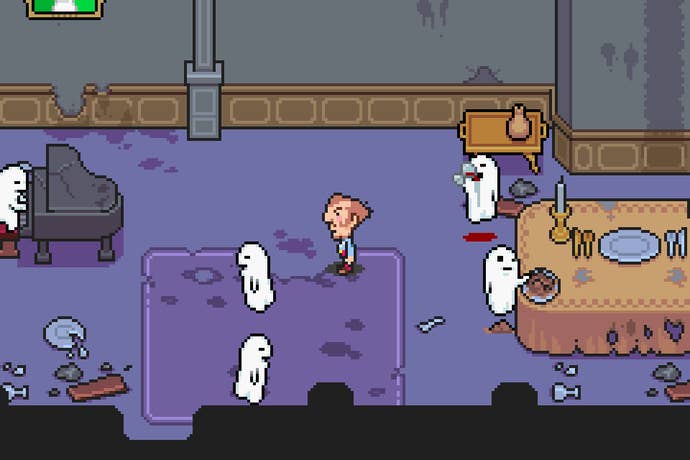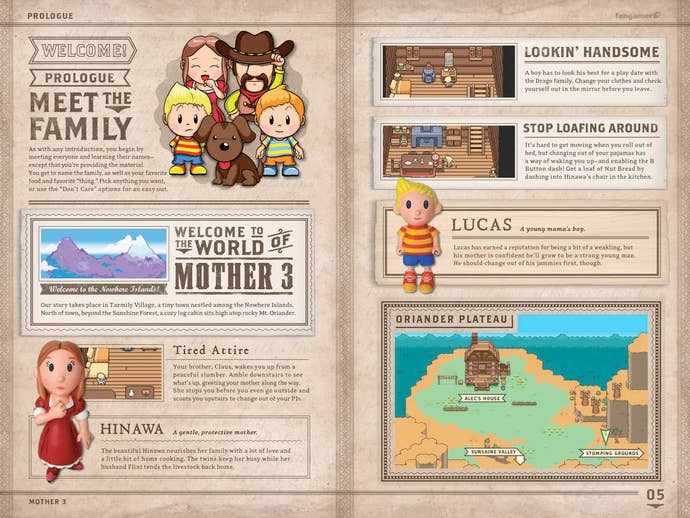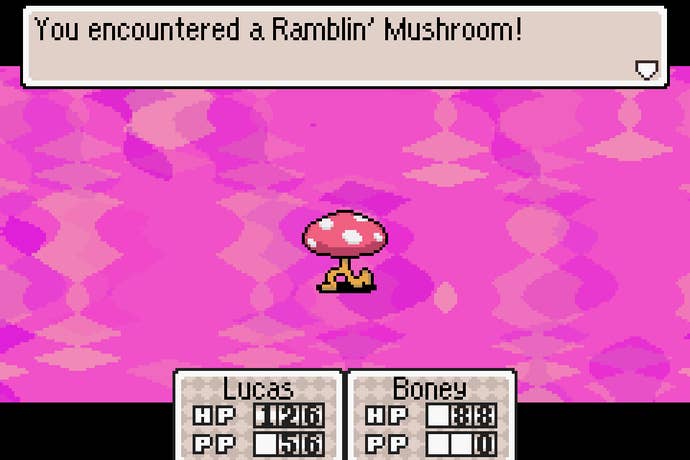How Mother 3 Escaped Development Hell to Become a Modern Classic
While this EarthBound sequel may never see an official English release, it still stands as one of Nintendo's greatest achievements.
This article first appeared on USgamer, a partner publication of VG247. Some content, such as this article, has been migrated to VG247 for posterity after USgamer's closure - but it has not been edited or further vetted by the VG247 team.
Until recently, those infatuated with Nintendo's EarthBound series have suffered more indignities than any other video game fanbase.
After a few attempts to make the role-playing genre catch on in America, 1995's EarthBound seemed the most likely to succeed. Eschewing the swords and sorcery trappings of series like Final Fantasy and Dragon Quest, EarthBound—released as "Mother 2" in Japan the previous year—played out as a globetrotting, modern-day RPG, filled with an atypical amount of genuinely funny jokes ranging from bone-dry to scatalogical. But, with video games of the mid-'90s awkwardly clawing their way towards realism, reviewers of the time didn't exactly jive with EarthBound's quirkiness and graphical style that, at first glance, could come off as primitive. Magazines largely panned EarthBound, and while it didn't bomb at retail, the costly localization and advertising campaign didn't help Nintendo of America's investment pay off.

The small-but-devoted EarthBound fanbase saw one glimmer of hope just a handful of years later: EarthBound 2 for the Nintendo 64 Disc Drive. While, like just about everything N64-related, this peripheral saw its share of delays, the tiny, blurry screenshots featuring a new, polygonal EarthBound adventure seemed almost too good to be true. This new game would drop Mother 2's focus on sunny Americana for a much more Old West setting, with a cowboy named Flint squaring off against an army of pigs for reasons yet to be explained. Finally, this series could get the second chance it needed to be viable in America.
Of course, the N64 DD didn't prove the best platform Mother 3: The add-on released exclusively in Japan in late '99, and without any truly worthwhile software to make it a convincing prospect for consumers. And Mother 3 had its own problems: Unlike with 1994's Mother 2—which also almost faced cancellation—no drastic overhaul could possibly save this project. On August 22, 2000, development of Mother 3 screeched to a halt, with only 30% of the game finished.
An official (and extremely comprehensive) interview with creator Shigesato Itoi, producer Satoru Iwata, and Nintendo legend Shigeru Miyamoto underlines the troubled development of Mother 3, and features some shockingly candid chatter about their failures with the game. "We couldn’t bring it all together with the N64 hardware," said Miyamoto. "I wonder if there even existed a method to bring it together. There were plenty of parts that couldn’t actually work on the N64 or that had a bad effect. It’d be nice if we could completely fix them by spending months and months revising the whole model and tinkering with the system, but in reality there were just so many issues…"
With Mother 3 being Itoi's baby, his comments during this extended interview come off as truly heartbreaking. "Of course I have a lot guilt. I had players ask me every single day when the game was coming out. I’m sorry. I’ve failed you."

A Second Chance
Clearly, Nintendo believed in Mother 3. And if you've followed their history over the years, you should know they're not likely to completely wash their hands of a scrapped project: The unexpected release of Mother on the Virtual Console—originally localized for the NES in 1990—proves no idea ever truly dies at Nintendo. Spurred on by his devoted fans, Itoi restarted the development of Mother 3 on the Game Boy Advance—with the help of Brownie Brown (now 1-UP Studio)—and announced the game via a tag at the end of the Mother 1+2 compilation commercial.
While this announcement delighted Mother/EarthBound fans over the world, those living outside of Japan couldn't help but feel some anxiety. As time stretched on, Nintendo of America's silence spoke volumes—and Mother 1+2 going unreleased in the States added even more salt to the wound. Had digital distribution been a possibility for Nintendo on the Game Boy Advance, Mother 3 might have had more of a chance outside of Japan, but releasing a cartridge-based game (with a costly localization) for a seemingly niche audience amounted to a risk they weren't willing to take. And it's important to note Mother 3 essentially released for a dead system: Coming 18 months after the Nintendo DS' launch, the decreased profile of the Game Boy Advance existed as one more strike against a possible American release.
Given the sheer rabidity of the EarthBound fan base, they weren't about to take this lying down. As expected, many fan translations kicked into gear, but only one managed to cross the finish line: A localization spearheaded by Clyde Mandelin, a professional translator and key figure in the EarthBound community. Working with the guts of Mother 3 proved to be a colossal undertaking, as the work involved much, much more than snipping out the Japanese characters and dropping English ones into their place. Despite just how much effort it took to simply get things working, the Mother 3 fan translation is phenomenally well-written, and perfectly communicates the dry absurdity and bittersweet emotions of Itoi's writing.

But this translation went far beyond a simple patch: The video game merchandise company Fangamer put together a comprehensive strategy guide for the game, similar to the travelogue-style player's guide that shipped with SNES EarthBound. And this impressive book stands as a love letter to Mother 3, with the Fangamer crew going so far as to make and photograph original clay models for nearly every character and enemy you meet in the game.
Close to eight years after releasing his translation patch, Mandelin reflects on Mother 3: "Looking back it's hard to believe it's already been 10 years since Mother 3 was released. It still feels unreal that it was released at all - I remember the day the Nintendo 64 version was cancelled like it was yesterday. More than anything, I've always been impressed with how different Mother 3 is from its predecessors and how it's able to stand as its own game. Yet, just like EarthBound, I feel that it's only improved with age. It's rare to find such a unique game that ages so well, and Mother 3 is one of them. Here's hoping that this classic will receive an official localization someday!"

Smiles and Tears
With so much drama surrounding its development, the whole "video game" aspect of Mother 3 often plays second fiddle to the theatrics surrounding its potential release. Simply having a new EarthBound game would be good enough for most fans, but luckily, Mother 3 is a great RPG—though one that makes some serious tonal shifts from its predecessor. While Mother 2 feels like a rambling, often improvisational tour of the world through the lens of Shigesato Itoi, Mother 3 takes a much more direct narrative approach. Overall, the story strives for a much darker, melancholy tone, and isn't shy about confronting the player with tragedy: Mother 3 opens with the loss of two important figures in the protagonist's life, and the remainder of the plot details the decline of a formerly peaceful world.
If you're coming to the game from the light-hearted silliness of the previous game, Mother 3's targets may surprise you. Itoi's themes come off as a mix between novelist Kurt Vonnegut and animator Hayao Miyazaki: A sort of world-weariness examining the flaws of "progress," but ultimately believing in the power of humanity. And, strangely enough, Mother 3 could be the first Marxist JRPG: Itoi certainly doesn't win any points for subtlety with his examination of how introducing currency to a peaceful, bartering populace leads to their corruption and gradual downfall.
Thankfully, the cast of heartwarming characters help sell Mother 3's on-the-nose message, and make for a much more lively crew than Mother 2's blank-faced, mostly silent youngsters. Perhaps the most notable among 3's cast is Duster, one of the few playable characters in a video game with a physical disability—and the only one I can think of at the moment. On the inclusion of Duster, Itoi remarked, "I figure that because there are handicapped people in our world, [they] would also be part of the world of Mother 3... The Mother 3 world is all about having friends like them. Perhaps you could call them symbols of not rejecting such people."

While Mother 3's narrative strikes a very different tone than the past game, there's no denying it features the best gameplay in the entire series. EarthBound features its share of forward-thinking ideas—ones that still haven't caught on in the genre—but its battles are ultimately shallow and, frankly, a bit broken. Mother 3 rethinks the Dragon Quest-inspired enemy encounters of the first two entries by subtly laying a rhythm game atop the turn based play: As your character launches an attack, you can continue pressing the button in time to the background music to land multiple hits. And since there's no Rock Band-style interface, players are tasked with using audio alone to determine when to strike. This ingenious idea adds a new element to battles, where tougher enemies don't just have more HP and stronger attacks—their songs make for more complicated compositions as well.
With Mother 3 turning out so great—often not the case with games whose development stretches across three platforms—it's a shame, then, that Nintendo hasn't made a peep about the possibility of an English release over the last decade. Though it's important to note Nintendo has given EarthBound a bit more respect since losing the Wii's mainstream audience: EarthBound and the localized Mother (known as EarthBound Beginnings) can be purchased from the Virtual Console service, which still feels surreal given the American branch's formerly ambivalent stance on the series. True, it's possible to play a fantastic fan localization of Mother 3, but this version requires a few hurdles to jump over first—hurdles that may keep more than a few potential fans away. It's a shame playing Mother 3 requires this extra bit of effort, but those willing to put in the legwork will be treated to not just a great EarthBound game, but one of the best JRPGs ever created.
All Mother 3 screenshots courtesy of Starmen.net.
